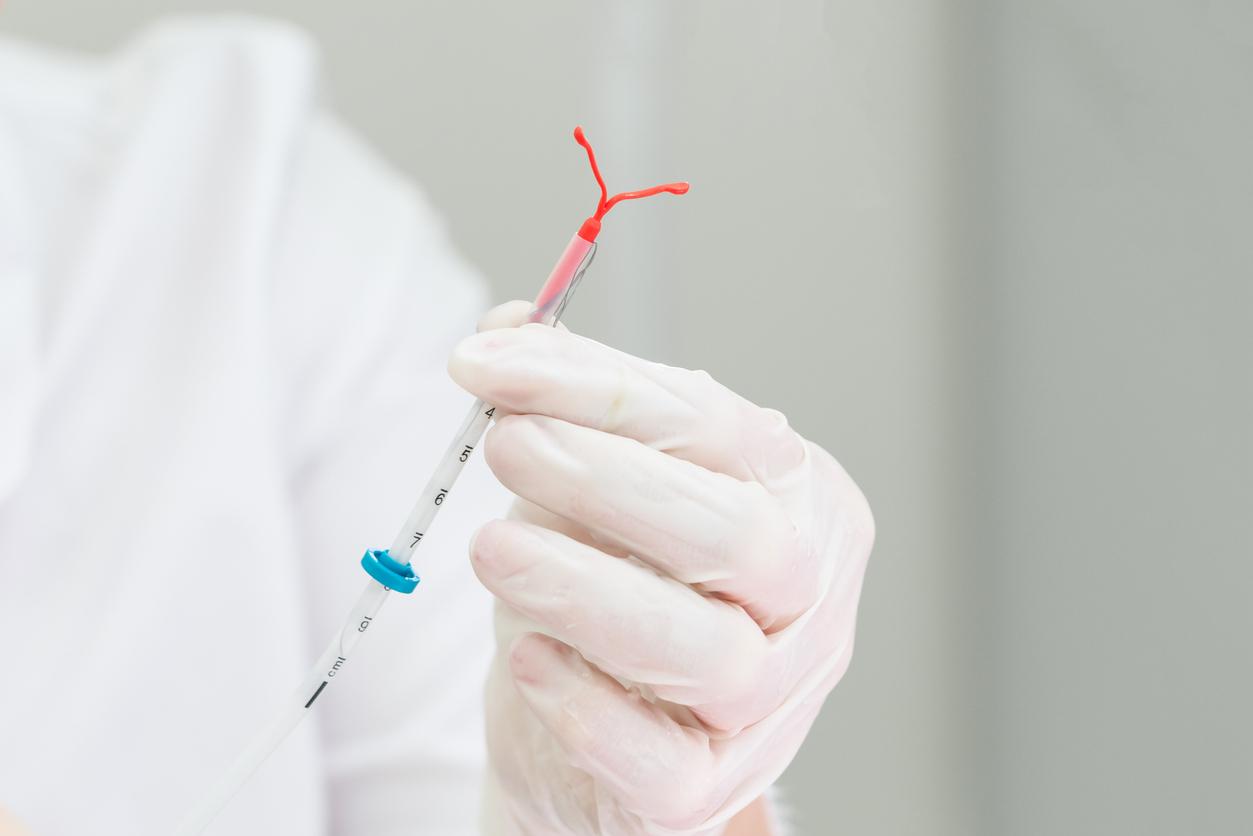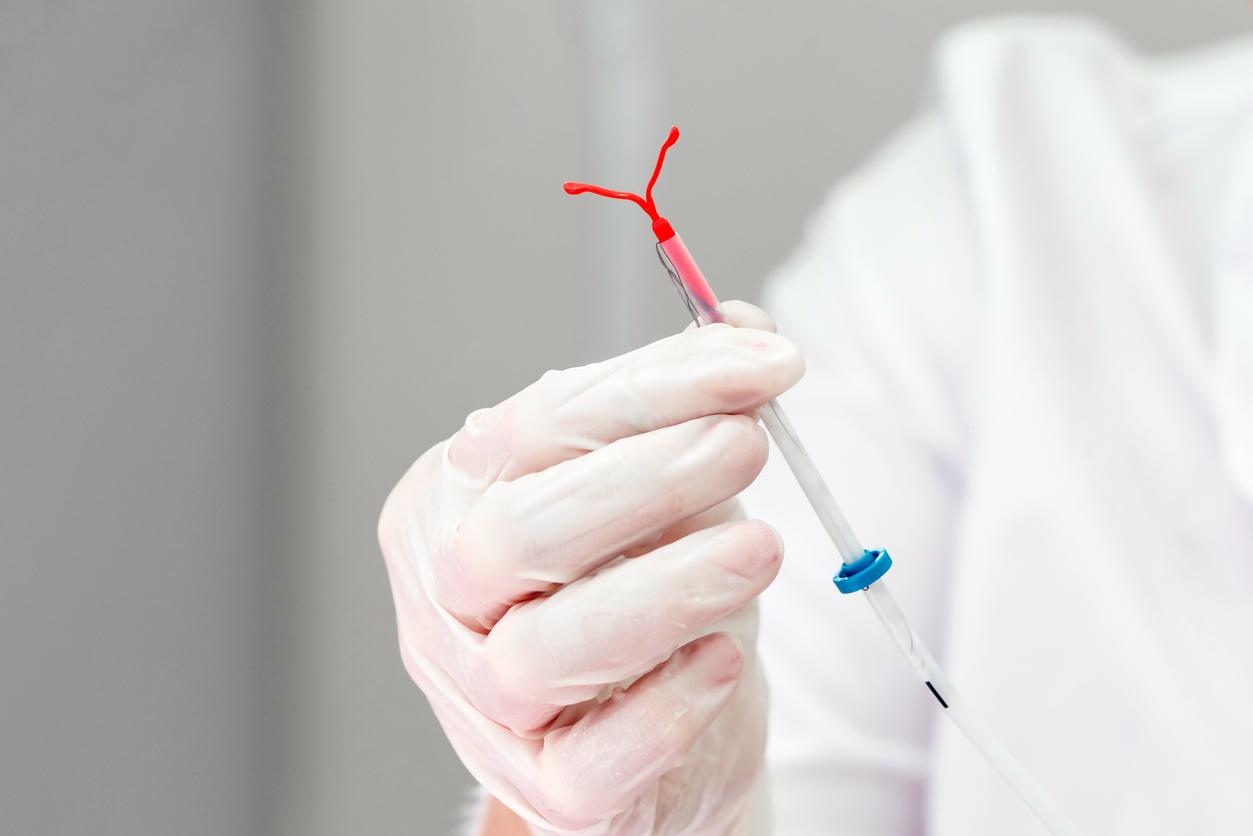- In which woman can a copper IUD be inserted?
- What are the contraindications for fitting a copper IUD?
- How is the pose going? Is it painful? Bleeding?
- Copper IUD: what are the advantages?
- What are the possible side effects ?
- How is the IUD removed?
- What price and what reimbursement for a copper IUD?
The IUD, also called an IUD (intrauterine device) is an intrauterine device that prevents the implantation of an egg. There are two types of IUDs: one with copper and the other with progesterone. They are shaped like a T (a vertical arm and a horizontal arm) or a ball (for a brand new IUD) and measure about 3 cm. “The copper IUD must be inserted by a gynecologist, an attending physician with additional training or by a midwife. It has a lifespan of 3 to 10 years”, informs Dr Amina Yamgnane.
In which woman can a copper IUD be inserted?
Contrary to what we can hear or read sometimes, IUDs can be inserted in women who have not had a pregnancy. “There are different sizes of IUDs. In women who have never given birth, we use a smaller IUD”, specifies the obstetrician-gynecologist. Copper IUDs are especially good for women who do not want hormonal contraception. However, if you have a heavy period it is better to have a hormonal IUD inserted because the copper IUD can worsen bleeding periods. “This leads to the end of periods in more than 80% of women”, informs Dr. Yamgnane. If you don’t want to have your period anymore, the hormonal IUD is a better choice as well.
What are the contraindications for fitting a copper IUD?
It exists two contraindications when inserting an IUD. First of all, a history of ectopic pregnancy. “The copper IUD increases the risk of recurrent ectopic pregnancy”, informs Dr Yamgnane. A malformation of the uterus (hemi-uterus, uterus with a septum, etc.) is a second contraindication to fitting an IUD. “The IUD does not hold well in women with a malformation of the uterus and it can have a pregnancy in the other horn while the IUD is placed in one of the horns of the uterus”, explains the obstetrician-gynecologist.
How is the pose going? Is it painful? Bleeding?
The insertion of an IUD is done after certainty of the absence of infection, and is done preferably during the rules to be sure not to insert an IUD while there is a pregnancy in progress (this would lead to a false lying down). If the insertion takes place outside the period of rule, a pregnancy test is performed the day before the insertion of the IUD and the IUD is inserted if the pregnancy test is negative. “Placing an IUD can be painful especially in women who have never given birth, informs Dr Yamgnane. This is why I recommend taking an analgesic medication 1 to 2 hours before the appointment scheduled for the installation to make it more bearable “. An ultrasound is done just after the insertion of the IUD by the gynecologist or secondly by a radiologist. It makes it possible to check that the IUD is correctly placed. “When the IUD is inserted outside of menstruation, the woman may notice a slight bleeding of short duration, this is normal and therefore nothing should be done. What should alert are hemorrhages, foul-smelling vaginal discharge or incessant pain within 48 hours after inserting the IUD “, warns the obstetrician-gynecologist. This must make urgently consult a doctor.
Copper IUD: what are the advantages?
Contraception with a copper IUD is very effective. “Its contraceptive safety is comparable to that of hormonal contraception (pill, patch, ring), says Dr Yamgnane. Other advantages of the IUD: it is a long-lasting contraception that does not require taking care of it every day like the pill and it does does not deliver hormones. “There is no drug interference”, adds the doctor.
What are the possible side effects ?
The copper IUD can have 3 side effects:
- It can already lead heavier periods in some women. “15% of women who have a copper IUD see their periods increase in volume and / or duration”, inform the obstetrician gynecologist. This creates a significant social handicap and is the cause in the medium term of anemia due to iron loss. “For these women, I recommend removing the copper IUD and fitting a hormonal progesterone IUD,” says the doctor who reassures women about the hormone level of this hormonal IUD: “The progesterone diffuses locally and the delivered dose is extremely low, 10 mg of progesterone per year, which means that the total hormone level of the hormonal IUD over 5 years is 20 times lower than a single intake of the contraceptive pill “.
- In unannounced pregnancy, there is a more frequent risk of ectopic pregnancy with an IUD than with a pill.
- Finally, the IUD “being a foreign body inside the uterus, if you are infected with a sexually transmitted infection (STI), the STD bacteria are grafted onto the IUD and this can cause more serious infections”, says Dr Yamgnane. “The IUD is for this reason the contraception of choice for stable couples”. If you have many sexual partners, you must protect yourself with a condom each time you have sex, even if you already have contraception.
How is the IUD removed?
Removal of the copper IUD is simple and generally less painful than insertion. The healthcare professional just needs to pull on the IUD threads that are visible at the level of the cervix. As with all other contraceptive methods, there is no need to stop contraception in advance.
What price and what reimbursement for a copper IUD?
Contraception with a copper IUD is inexpensive contraception. “A copper IUD has a cost of 30 or 40 years euros, and 130 euros for a progesterone IUD, for an average duration of action of 5 years”, says Dr Yamgnane. The copper IUD is reimbursed up to 65% by Social Security. Some mutuals can pay the remainder. This makes it the cheapest contraception on the market!
Thanks to Dr Amina Yamgnane, Obstetrician Gynecologist Head of Maternity Department at the American Hospital.
Read also:
- Defective IUDs: the French Medicines Agency encourages women to consult
- Testimonial – Vasectomy “to finally take responsibility for contraception in the couple”
- Contraceptive ring: how to put it? what advantages?
- What is the best contraception for me? Take the test!

















